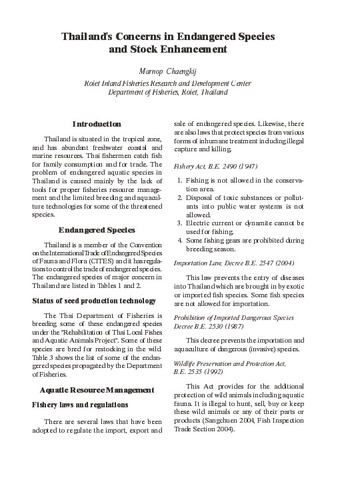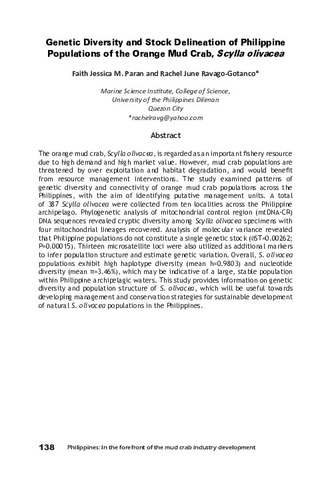Population genetic variation and genetic structure of widely distributed Japanese endemic freshwater crustaceans: Geothelphusa dehaani and Gammarus nipponensis
- Global styles
- MLA
- Vancouver
- Elsevier - Harvard
- APA
- Help
Date
2024Author
Page views
751ASFA keyword
AGROVOC keyword
Taxonomic term
Geographic names
Metadata
Show full item record
Share
Abstract
Freshwater crustaceans, Geothelphusa dehaani (White 1847) and Gammarus nipponensis (Ueno 1940), are commonly found in rivers, streams and lakes in Japan. The distribution range of G. nipponensis is concentrated in the Western portion of Japan while G. dehaani exhibits a more widespread distribution. Both species undergo direct development from eggs to juveniles and have limited migratory abilities, as they are intolerant to brackish and marine environments. This restricted dispersal capability leads to geographical isolation among populations, making these freshwater crustaceans as ideal models for studying gene flow. Despite their significance, there were scarcity of studies that clarified genetic patterns in these two widely distributed crustaceans. Thus, the objectives of this thesis were to conduct genetic assessments on both G. dehaani and G. nipponensis to understand their population structure and variation, and to provide insights into past geological events that have contributed to these variations. Here, mitochondrial DNA sequence data were utilized to infer the relationships between the local populations of these species.
Results of this study revealed substantial genetic variations among populations in both crustaceans. In G. dehaani, distinct haplotypes were observed in most populations, while G. nipponensis exhibited remarkably high mitogenome sequence variability across different localities. These findings implied extremely limited gene flow within each population and a reduced capacity for migration over extended periods, a characteristic that distinguishes them from other strictly freshwater species. The time to most recent common ancestor (TMRCA) estimates proposed that the ancestor lineage of G. dehaani was introduced more recently in Japan, approximately around the Pleistocene (~1 million years ago), while that of G. nipponensis predates the separation of Japan from mainland Asia around late Oligocene (~24 million years ago). Despite these differences, the structural patterns of populations in both species appeared relatively similar.
Based on the phylogenetic analysis, the populations in both species are considered highly monophyletic with several geographical groups detected. In G. dehaani, four distinct geographic groups formed: Clade I (Honshu and Shikoku), Clade II (Eastern Kyushu), Clade III (Southern Kyushu and a portion of Eastern Honshu) and Clade IV (Western Kyushu). In G. nipponensis, the three identified groups were Clade I (Honshu and Shikoku), Clade II (Eastern Kyushu) and Clade III (Western Kyushu). The geological boundaries separating these major clades consisted of ancient lowlands such as the present Seto Inland Sea and the Chikushi and Fukuoka plains, acting as barriers for gene flow. The Seto Inland Sea potentially contributes to the divergence of Clade I from the Kyushu group. Despite the Seto Inland Sea acting as a barrier, Honshu and Shikoku displayed closer genetic relationships, possibly attributed to their more recent separation. Likewise, the Chikushi and Fukuoka plains was a significant barrier, defining distinct genetic groups in Kyushu.
In conclusion, this study emphasized the importance of these two freshwater crustaceans in understanding genetic relationships characterized with limited gene flow and the impact of geological events on their population dynamics in the Japanese Archipelago. The need for further examination of morphological and behavioral characteristics based on the genetically detected groups of G. dehaani and G. nipponensis is suggested.
Keywords
gammaridSubjects
CrustaceaSuggested Citation
de la Cruz-Huervana, J. J. (2024.). Population genetic variation and genetic structure of widely distributed Japanese endemic freshwater crustaceans: Geothelphusa dehaani and Gammarus nipponensis [Unpublished doctoral dissertation]. Kyushu University.
Type
ThesisCollections
Related items
Showing items related by title, author, creator and subject.
-
Emergency response to emerging diseases: TiLV in tilapia
Senapin, Saengchan (Aquaculture Department, Southeast Asian Fisheries Development Center, 2019)Tilapia lake virus (TiLV) is a novel RNA virus resembling Orthomyxovirus. It has been recently re-classified to Tilapia tilapinevirus species, under Tilapinevirus genus, Amnoonviridae family (ICTV, 2018). Since the first ... -
Thailand's concerns in endangered species and stock enhancement
Chaengkij, Marnop (Aquaculture Department, Southeast Asian Fisheries Development Center, 2006)The paper provides a comprehensive list of endangered freshwater, brackishwater, and marine aquatic species in Thailand. The Thai Department of Fisheries is breeding some of the endangered species under the “Rehabilitation ... -
Genetic diversity and stock delineation of Philippine populations of the orange mud crab, Scylla olivacea
Paran, Faith Jessica M.; Ravago-Gotanco, Rachel June (Aquaculture Department, Southeast Asian Fisheries Development Center, 2017)The orange mud crab, Scylla olivacea, is regarded as an important fishery resource due to high demand and high market value. However, mud crab populations are threatened by over exploitation and habitat degradation, and ...







